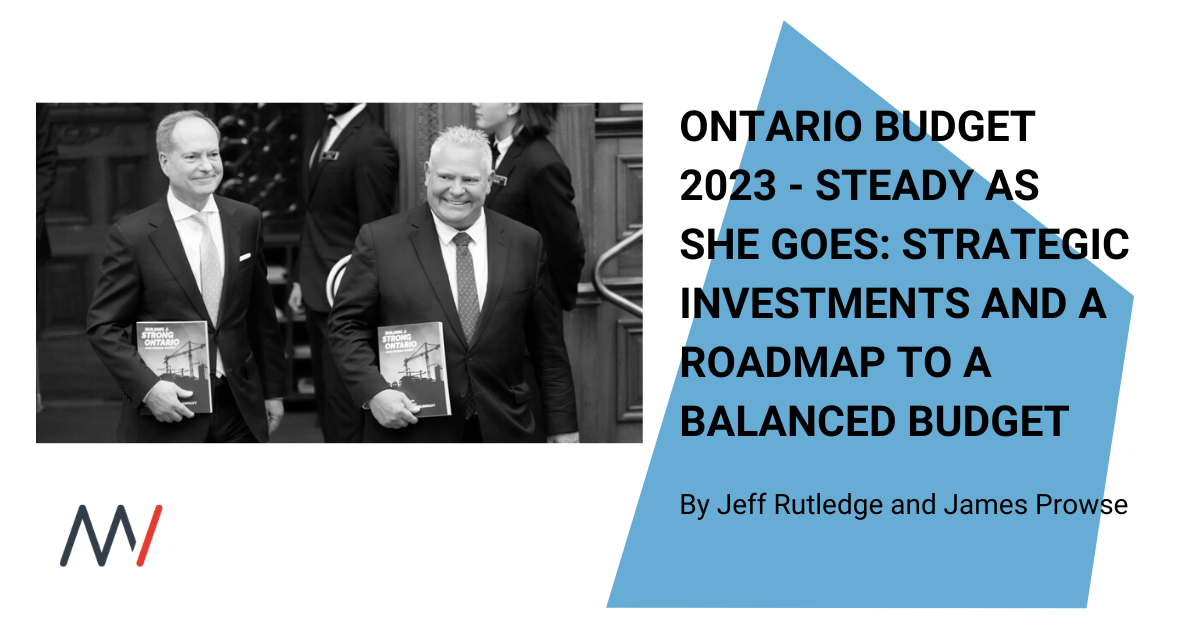What You Need to Know about Ontario’s 2023-24 Budget
On the heels of the Ontario PC’s election victory last June, Ontario Finance Minister Peter Bethlenfalvy tabled the government’s first budget of its renewed mandate. Today, Minister Bethlenfalvy introduced the government’s path to balance. The government is on track to post a surplus in 2024–25, three years earlier than forecast in the 2022 Budget.
Against this backdrop, an increasingly difficult inflationary and macroeconomic environment starkly contrasts with the Ford government’s good news positioning. Notably missing from Budget 2023, however, is any mention of upcoming public sector labour negotiations. The Ford government will undoubtedly be challenged internally and in the headlines by looming labour negotiations with teachers and nurses’ unions.
Key priorities underpinning Budget 2023 include investments in healthcare, manufacturing, and bolstering Ontario’s critical mineral sectors – the same priorities discussed during last year’s provincial campaign. Other areas that are sure to define the government’s legislative agenda over the next year include: growing Ontario’s economy, embarking on ambitious capital projects like highways, public transit, and other critical infrastructure, fostering collaborative relationships with workers and organized labour, as well as keeping the cost of government down.
By the Numbers
- Total Revenues: $200.4 billion – $20.6 billion higher than forecast in the 2022 Budget.
- Programs Expenses: Ontario’s program expense outlook is expected to grow from $189.1 billion in 2022–23 to $202.5 billion in 2025–26.
- Total Deficit: $2.2 billion, $17.7 billion lower than the outlook published in the 2022 Budget.
Key Investments
- Manufacturing Renaissance
- Growing Ontario’s Economy: Another commitment made in today’s Budget is a 10 per cent refundable corporate income tax credit of up to $2 million a year for Canadian-controlled private corporations. To strengthen the Ontario economy and stimulate activity, this corporate tax credit is aimed at helping companies purchase buildings, machinery, and equipment for manufacturing and similar processes.
- Clean Energy Advantage
- Launching the Voluntary Clean Energy registry to boost competitiveness – A CEC registry will provide provides businesses with a tool they will need to meet emissions goals and demonstrate that their electricity has been sourced from clean resources, such as hydroelectric, solar, wind, bioenergy, and nuclear power. Funds generated through the purchases of CECs could be returned to ratepayers to help lower electricity costs and support future clean energy generation.
- Investing $3 million per year over the next two years into the Ontario Junior Exploration Program and amendments to the Building More Mines Act to support a modern and competitive regime for mineral exploration and development.
- Building Ontario’s Highways, Transit, and Infrastructure: ambitious capital projects
- Recommitments to key infrastructure projects, including Highway 413, Bradford Bypass, QEW Garden City Skyway Bridget project, Highway 7, etc.
- Providing funding for LRT projects, building transit-oriented communities, and investing in subways and Go Transit to alleviate gridlock.
- Working for Workers
- Before last year’s election, the Ford Tories invested in building relationships with private sector labour organizations – the PC’s “Big Blue Collar Machine.” Budget 2023 doubles down on their approach to working “hand-in-hand with labour unions” to fill Ontario’s skilled trades shortage and to strengthen Ontario’s economy through the labour force. Among commitments to workers, Budget 2023 provides a $224 million top-up to the Skills Development Fund.
- Keeping Costs The Cost-Of-Living Down:
- Expanding access to the small business Corporate Income Tax (CIT) rate. The small business limit phase-out range would be increased from $10-15 million to between $10 and $50 million. Increasing access to an additional 5,500 small businesses.
- Continuing the electricity price relief for residents and businesses.
The Bottom Line
The Ford Tories have been hawkishly pragmatic and disciplined in their messaging and strategic approach to spending. Budget 2023 zeros in on cost reduction and customer service modernization. Equally important, the government forecasts path back to balance by 2024, setting the stage for more politically focused budgets leading up to the 2026 election.
However, given the Ford government’s fiscally hawkish approach, three questions remain: What happens to government dollars not allocated within the Budget? How do my organization’s policy needs become prioritized? And with pandemic spending ending, how will my organization adapt?
McMillan Vantage is here to help your organization answer these questions, navigate Queen’s Park, and keep your issues at the top of the agenda. To find out more, contact us at info@mcmillanvantage.com.
